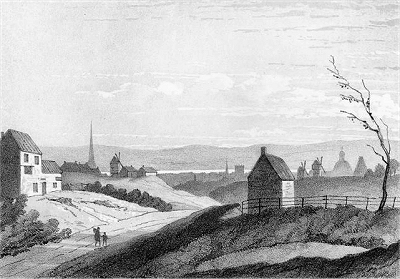| In the summer it was
the delight of holiday-makers. A day's out to the
Beacon, at Everton, was a very favourite
excursion. The hill-side on Sundays used to be
thronged with merry people, old and young. The
view obtained from Everton Beacon-hill was a view
indeed. And what a prospect! What a noble
panoramic scene! I never saw its like. I do not
think, in its way, such an one existed anywhere
to be compared with it. At your feet the heather
commenced the landscape, then came golden
corn-fields and green pasture-lands, far and
wide, until they reached the yellow undulating
sand-hills that fringed the margin of the broad
estuary, the sparkling waters of which, in the
glow and fullness of the rich sunshine, gave life
and animation to the scene, the interest of which
was deeply enhanced, when on a day of high-tide,
numbers of vessels might be seen spreading their
snowy canvas in the wind as they set out on their
distant and perilous voyages. |
|
| In the
middle ground of the picture was the peninsula of
Wirral, while the river Dee might be seen
shimmering like a silver thread under the blue
hills of Wales, which occupied the back ground of
the landscape. Westward was the ocean, next, the
Formby shore attracted the eye. The sand-hills
about Birkdale and Meols were visible. At certain
seasons, and in peculiar states of the
atmosphere, the hummocks of the Isle of Man were
to be seen, while further north Black Combe, in
Cumberland, was discernible. Bleasdale Scar, and
the hills in Westmoreland, [were to be] dimly
made out the extreme distance. [...] The eye
moved then along the Welsh hills until it rested
on the Ormeshead and travelled out upon the North
sea. Below us, to our left, was the town of
Liverpool, the young giant just springing into
vigorous life and preparing to put forth its
might, majesty and strength in Trade, Commerce
and Enterprise. [ROL] |
|
 |
| Liverpool
from Low Hill c.1840 |
|